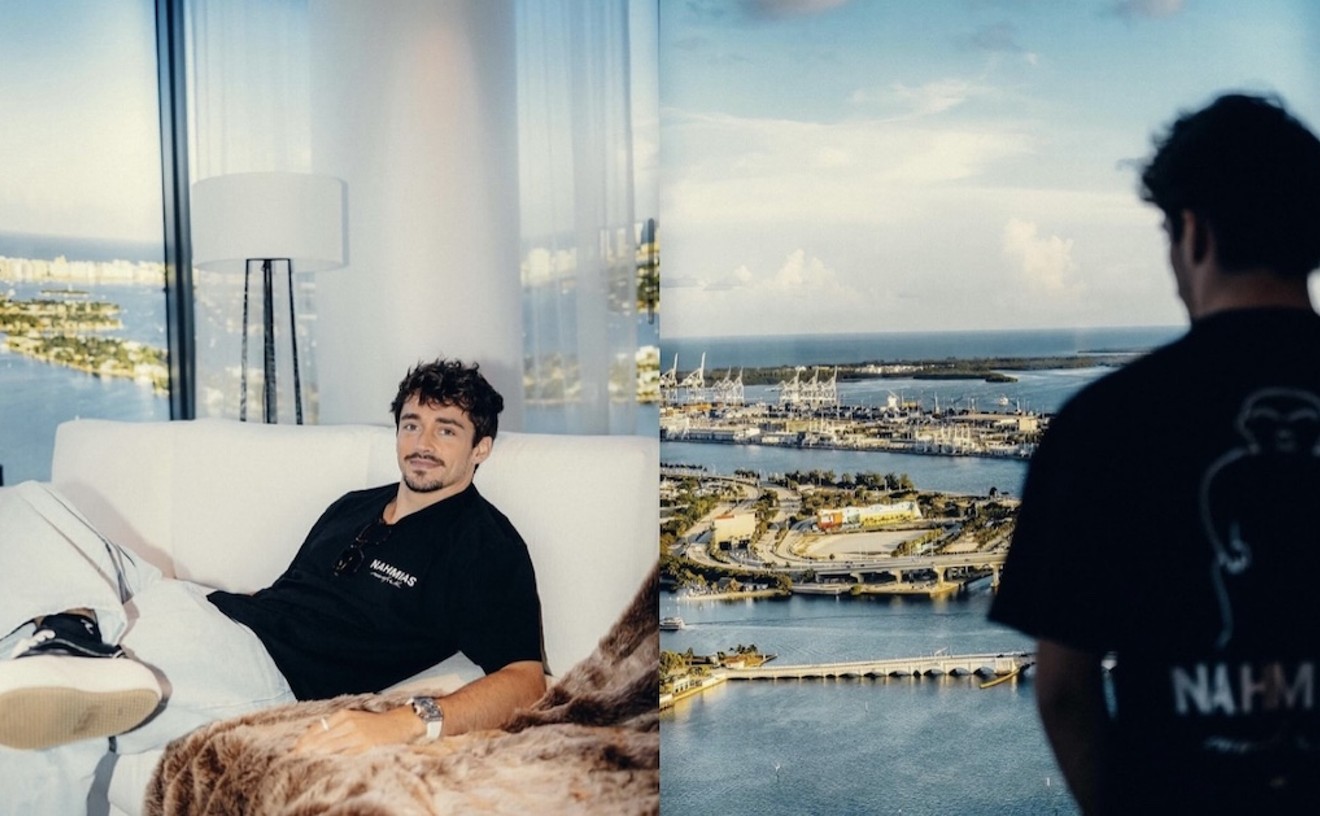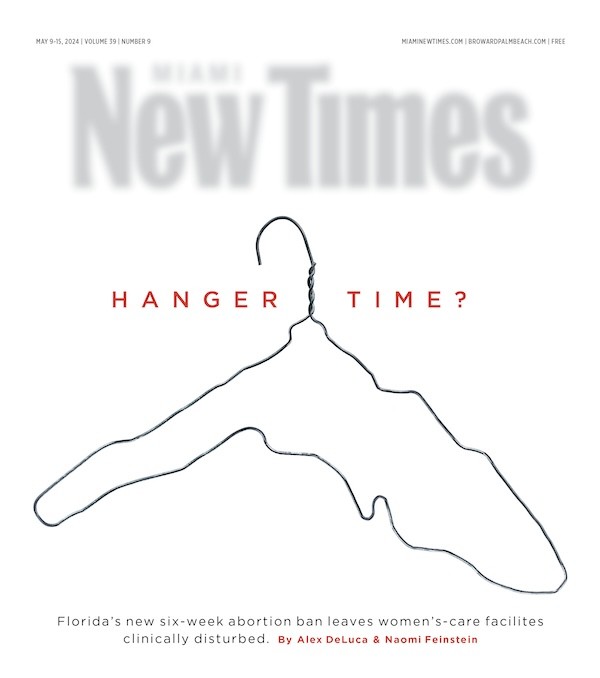Florida East Coast Railway engine 441, pulling a short, eleven-car train of assorted goods, slowly rounds a 90-degree eastward turn near Okeechobee Road and the Metrorail corridor along NW 74th Street, and gradually increases its speed to 35 miles per hour, cutting through a dozen automobile crossings from Hialeah Park racetrack to NE Second Avenue, where the rail curves 90 degrees to the north. As Wade increases the throttle to 45 miles per hour, the backsides of Sixties-era cinder-block houses begin rouletting by like an unfurled roll of postage stamps. Baseball fields, Miami Shores Country Club, and Greynolds Park break up the monotony of shopping centers, office buildings, and restaurants. Approaching the Broward County line: dilapidated warehouses, more cinder-block homes, and a day-care center, all on the edge of the railroad's 100-foot right of way. Davis notices that an old-style McDonald's restaurant, where the golden arches once loomed large and airy, has been leveled and replaced with a nondescript building. He seems saddened by the change.
"From here to Lake Worth it's a concrete jungle," says Wade, his voice rising like a melodic riff over the reverberating drone of the train's 3000-horsepower diesel engine. Wade, 49 years old, and Davis, age 53, railroad and family men for more than twenty years, make the Jax-Miami-Jax roundtrip three times each week. Davis lives in St. Augustine, Wade in the Jacksonville suburb of Orange Park. They don't much like what they see in South Florida.
It's not until the train pushes north of West Palm Beach, especially up around Ormond Beach, that Wade and Davis truly enjoy the ride. "You see wild turkeys and hogs, deer crossing the tracks, trees -- nobody's throwing rocks at you," Wade points out. "It's God's country."
The funny thing is that Wade and Davis, who can't wait to turn their backs on metropolitan South Florida, are the beneficiaries of Henry Flagler's master plan. Flagler's Florida East Coast Railway, which he founded in 1895, spurred development from Jacksonville straight down to Key West. Then as now, the FEC Railway transports the materials and products that support South Florida's continuing development -- lumber, crushed limestone, and cement for roads and building construction; new cars that clog streets and highways; food and other consumer goods that sustain an ever-increasing population. Although Wade and Davis would rather be fishing and hunting in the north Florida wilds, their livelihoods depend on the uninterrupted growth of the state's east coast. And by the same token, that stretch has been largely dependent on the FEC Railway.
The first FEC Railway men who rolled into Miami in April 1896 aboard a Schenectady steam engine pulling a six-car passenger train could not have imagined the megalopolis of contemporary South Florida. Even their boss, Flagler, had modest expectations. He envisioned Miami, then an outpost of several hundred people, becoming no more than a year-round fishing village and a winter resort with a nice passenger train station. Instead Miami, with the help of the FEC Railway, took off, with the downtown passenger station at 200 NW First Ave. growing to become six tracks wide and tying up traffic until 1963, when a labor strike halted passenger travel and the company closed the station.
Even if it is no longer vital to passenger transportation, the old FEC remains integral to Miami commerce as a freight carrier. "The FEC is now a low-key operation but it is the freight lifeline of the east coast of Florida," contends FEC Railway historian Seth Bramson. "It's totally indispensable. Think about the total gridlock, the tens of thousands of trucks that would have to be on the road today. There would be a 350-mile, Jacksonville-to-Miami traffic jam, 365 days a year, 24 hours a day."
Jim Keeley, a paunchy, pipe-smoking gumshoe, drives around the FEC's Hialeah station yard in his blue Ford Explorer. The yard is located in unincorporated Dade County, wedged between Miami Springs and Medley from NW 25th Street at the south to NW 74th Street at its northernmost end. Squat, desert-brown barracks that house the security, operations, and maintenance departments dot the yard. A lime-green, three-million-gallon diesel fuel tank sits in the middle of the yard, the fuel piped in from Port Everglades. Hovering over the central track is a three-story lookout tower, which affords a great view of the hundreds of tractor-trailer containers that are parked diagonally in the yard, or that sit on railroad flatcars.
The railway subcontracts most of the work at the Hialeah yard, including the loading and unloading of freight containers accomplished through the use of 60-foot yellow cranes. A two-story building, with four traffic lanes on each side, serves as the receiving and checkout terminal for truckers. The yard handles about 1000 containers of freight every day.
The 42-year-old Keeley, FEC's chief of police, supervises the railway's twenty security guards and ten police officers, the latter sworn to duty by the governor. The railway's police, five of whom are based in Miami, have arrest powers. Keeley drives up and down the state investigating accidents or testifying in court, but his base of operations is the Hialeah yard. He knows the first word most think of when they hear train is wreck, and so he declines to talk publicly about the bulk of his work. The FEC Railway reported 27 crossing accidents last year. (Recent headlines: "Man dies as truck barrels into train" and "Train decapitates man lying on tracks.")
Trespassing isn't much of a problem in the Hialeah yard, Keeley notes, owing to the canals bordering its length -- home to alligators and freaky four-foot-long iguanas. Trespassing on the tracks, especially in Hialeah, is a different story. Practitioners of Santeria regularly arrange offerings on the tracks. Paper bags stuffed with gutted, still-feathered chickens, bloody skirt steaks, and broccoli in plastic freezer bags are a few of the items Keeley finds shredded by trains. Santeros say they are spreading wealth across the country when a train strikes one of their prepackaged sacrifices. Keeley has never arrested a Santero for trespassing, but he'll occasionally bust a hobo and send him off to jail. Rarely are smuggled drugs or other contraband found on train property, and U.S. Customs handles that anyway. Railway crime is decreasing, he claims. Besides the eight video surveillance cameras around the yard, there's nothing new on his beat. He's been with the railroad for 23 years, the last six as chief. His father was also FEC Railway chief of police.
A genial golfer, model-train collector, and railroad buff, Keeley drives over to the yard's westernmost track to admire a black 1925 steam-engine crane mounted on a flatcar. The old steamer actually sees some action now and then to hoist or pull broken-down or slightly derailed trains. Back in the Explorer heading toward the yard's 1200 paved acres of parking for new automobiles, Keeley segues into infomercial mode: "This is the southernmost [railway freight] yard in the United States. The seventh-largest railroad yard in the country in freight volume. Most of the train travel is at night. An average of 22 trains a day, the average [train] a mile and a quarter long. Hoppers, boxcars, trailers, refrigerated containers, tank cars; rock, wallboard, corn syrup A you name it, every kind of commodity." After a few quiet moments, he adds, "I love the railroad."
Roger Barreto was born in Key West in 1922 and has lived since 1928 in Miami. After 52 years with the FEC Railway, he retired in 1992, but he can still be found in a pinstripe suit A his tie knotted just so, as if he were interviewing for the job A Wednesday mornings in his office at Gran Central Park off NW 116th Way in Medley. His consulting work there relates primarily to the railway's real estate arm, the Gran Central Corporation. (Both companies are subsidiaries of FEC Industries.) Barreto, patriarch of a clan of four daughters and seven sons, including Miami Beach Police Chief Richard Barreto and Miami political lobbyist Rodney Barreto, is a robust man who rose through the railway ranks by combining a down-to-earth, railroad-man personality with the refined instincts of a business executive. When he finally retired, he was vice president of FEC Railway and Gran Central Corporation.
As a railway executive, Barreto has been well placed in Dade County business circles: past president of Business Inc. and Rotary, and current chairman of the Industrial Development Authority of Dade County and the Property and Asset Review Committee for the City of Miami.
"I've always been 100 percent railroad," says Barreto, inching forward over his neat desktop and folding his arms comfortably across his chest. "I'd go to all the hearings and meetings and try to get as much as I could for the railroad. Buying low and selling high." He pauses to sip American coffee. "Miami grew and we grew with it. We were not a power player in politics, but we had a foot in the door. We had the ability to talk to the people in power." Barreto recalls a conversation in the early Eighties he and FEC Industries chairman William Thornton had with then-Miami Mayor Maurice Ferre. The subject of a sports arena came up, and Barreto had a suggestion: "I told Maurice, 'There's a site that I like, that I think is being overlooked, and that's the Overtown site -- and in fact if you happen to pick it, I'll donate a little piece of land there, along Seventh Street, to make sure the project goes through.' I looked at it two ways. It would enhance the value of our property and also utilize the Metrorail's Overtown station, which was not being used at all. And if we built an arena there, that would trigger cleaning up that whole area. And so Maurice took the bait." The punch line, Barreto adds, is that FEC is making a handsome profit from the parking lots it owns in the arena neighborhood.
Another deal Barreto oversaw was the sale of the FEC dock property just south of Bicentennial Park; it is the proposed site of a new sports arena. In the early Eighties, the company tried to sell the 32 acres to the city for $12 million. But the city opted to condemn the property instead. After eleven years of legal wrangling between the two parties, the city was ordered to compensate the railway approximately $25 million for the land, plus a two-million-dollar reimbursement for legal fees. One of the last transactions Barreto negotiated was the 1988 sale of the South Dixie Highway Metrorail corridor, from Kendall Drive to Florida City. Metro-Dade paid the FEC Railway $23 million for that property.
The selling of old FEC land is the latest spinoff of Henry Flagler's money-making legacy. Flagler's venture in Florida began after he had made a fortune as a founder of the company that later became Standard Oil. His plan for developing Florida's east coast began in 1885, when he bought the decrepit Jacksonville, St. Augustine & Halifax River Railway Company in order to transport materials to build his Ponce de Leon Hotel in St. Augustine. Flagler then upgraded the railway for luxurious passenger travel for the hotel's well-heeled vacationers. Extending his railroad, Flagler eventually applied the same two steps to his other hotels in Ormond Beach, Palm Beach, Miami, Long Key, and, with the addition of his steamship company, to Nassau. The second phase of the plan called for the dozen settlements along the railway to produce cash crops the railway would then haul to market. Flagler was aware that rich soil lay south of the Miami River and that between the coastal hammocks and the Everglades stretched pine forests that were valuable as building material and fuel. And once the land was clear-cut and crops planted, the railroad company stood to profit greatly.
By 1906 Flagler's railway began its push down to Key West because, as Barreto puts it, "Hey, there just wasn't that much in Miami." Key West, however, was thriving; its 17,000 residents comprised one of the most prosperous communities in the nation. When completed in 1912, the FEC Overseas Railroad linked Miami to Key West. Some called it "the Eighth Wonder of the World," and the two-and-a-half-mile Long Key viaduct became part of FEC's corporate logo, appearing on letterhead and timetables. Flagler died within a year of the completion of his greatest feat.
It was the prospect of a job on Flagler's FEC Railway that encouraged Barreto's father, Rogelio Barreto, a railway telegraph operator in Camagey, Cuba, to emigrate to Key West in 1912. The company needed Spanish speakers, and the senior Barreto hired on as a trainman, a kind of railroad handyman, eventually rising to the post of conductor. He married Conch native Ana Rosa Vila, and for a while, especially in the early Twenties, their lives were good and work was profitable.
"Railroad did pretty good until about '27, '28," Roger Barreto recalls. "But the Depression hit Florida early. Traffic didn't warrant service to the Keys, so Dad moved to Miami. It got so bad they celebrated if a train came in with one carload of goods. Nobody had money to buy anything. There was no building going on. There was just no money to be made."
Lacking sufficient cash flow to sustain itself in the slow times, the railway fell into bankruptcy in 1931, which left it helpless when four years later a Labor Day hurricane completely destroyed 40 miles of track in the Keys. The FEC then sold the Overseas Railroad, Flagler's $50 million investment, to the State of Florida for $1.4 million. In its place the state built what it termed the Overseas Highway, which opened on July 4, 1938.
The Barreto family suffered its own dark turn during this period. Rogelio was dropping off some train cars in Homestead one night in 1932 when he slipped and was clipped by a moving train car. The injuries required amputating first his toes, then his feet. Within a few days of the accident, he caught pneumonia and died.
During World War II, the FEC Railway enjoyed an economic resurgence, profiting for a few years from the transport of military equipment and personnel. In 1945 a federal bankruptcy court appointed new trustees for the railway, and the Flagler estate gave way to the estate of Alfred I. duPont, who had been buying FEC bonds at eleven cents on the dollar since the early Thirties. The railway eventually emerged from bankruptcy in 1961. Ed Ball, who along with his brother-in-law duPont had scoured northern Florida in the Thirties buying up farmland, pine forests, and failing banks, took the reins of the railway. With assets that included the St. Joe Paper Company in the Florida panhandle, 31 banks, and one million acres of pine forest, Ball became one of the most powerful men in Florida.
"When Mr. Ball finally got [the railway], it was debt-free, and to this day it's debt-free," says Roger Barreto, who landed his first job with FEC as a stenographer in January 1940, six months after graduating from Gesu High School. Barreto hadn't considered the railroad as a career until he asked Al Hirsch, owner of Southeastern Optical Company, for a job. Hirsch, an old friend of Rogelio, suggested that Roger work for the railway instead, and set him up with an interview at FEC. Hirsch even paid for Barreto's tuition to learn typing and shorthand in order to get the job. He gradually worked his way up the railway ladder to become an engineer.
In the Fifties, passenger travel picked up until a union strike by railroad workers brought FEC Railway passenger service to a halt in 1963. Nationwide, strikers demanded a ten-cent-per-hour pay increase -- immediately. Here in Florida Ball countered by offering twelve cents per hour, to be paid incrementally over a year. The workers refused, and after three years of unsuccessful negotiations, Ball decided to cut his losses and disband passenger service altogether. Rather than pay workers more money to maintain a mediocre profit on passenger travel, Ball opted to reinvest in heavier rail to upgrade the freight business. And while the national strike lingered until 1974, the airlines surpassed the railroads as the most popular means of travel.
Just as the 1960s marked a fundamental change for the FEC, so too did South Florida undergo a tremendous transformation during the decade. The Latinization of the area begun by an exodus of Cubans from Castro's regime reinvigorated the FEC Railway in unexpected ways. "We became a hub for Latin America and we encouraged these Latins to get into the import-export business," Barreto explains. "We started an industrial park west of the airport called Commerce Park, and we encouraged those guys [importers-exporters], tried to help them out, sold them land. They handled the paperwork and we would handle the bulk. The bottom line in our end was handling export, which was growing. They went out there touching base, communicating with people in South America."
From the late Sixties to the present, under the direction of William Thornton, the FEC has steadily moved into the real estate business. Barreto: "Somewhere along the line our directors, knowing that our property could be used better than just keeping it as railroad property, determined that we should form a new company called Gran Central Corporation. So we got the profits from the railroad and put it into building industrial parks, developing industrial land."
Barreto waves a hand toward his office window to indicate the office park outside: "When I bought this land, it was for the railroad, then it was transferred over to Gran Central. All these buildings you see, three million square feet, all highly landscaped, streets very nice and very clean A this is the modern part of the railway."
Indeed, Barreto's successor, Ray Jones, doubles as vice president of the FEC Railway and the Gran Central Corp., dividing his workload but spending most of his time managing Gran Central's leases and property. Middle-aged and with no children, Jones is all business. And while business is good, he says he's concerned about the company's future. This past February the St. Joe Paper Company, which now owns 54.5 percent of FEC Industries' stock (the remainder is publicly held), announced its intention to sell its controlling interest. "St. Joe is definitely in flux right now," Jones says. The two principal companies that seem most interested in buying out St. Joe are Norfolk Southern Railway and CSX Transportation. (CSX owns the other other major railway line in Miami, which serves both freight trains and the passenger trains of Amtrak and Tri-Rail.)
The FEC Railway owns approximately 12,000 acres of land along Florida's east coast devoted to railroad operations between Jacksonville and Miami. Gran Central owns and manages approximately 19,146 acres throughout the state, including nearly 1700 acres in Dade County and 60 in Broward. Together FEC and Gran Central employ nearly 1100 people. The asking price for both companies, according to Jones, is $800 million.
The latest in the Flagler line of promoters and developers, Jones characterizes the modern FEC Railway with a salesman's zeal. "I think as long as Miami continues to be the gateway to the Americas that that's going to continue to increase our business," he says. "More and more large steamship lines are calling at Port Everglades and the Port of Miami and dropping containers, picking up containers. That increases our business. The railroad is a viable entity and an important entity as far as the development of Florida is concerned. That can't be downplayed. Because without a railroad, without a transportation arm, it's just like being in the middle of nowhere. If you can't get product there, if you can't get freight there, the area's going to die.










